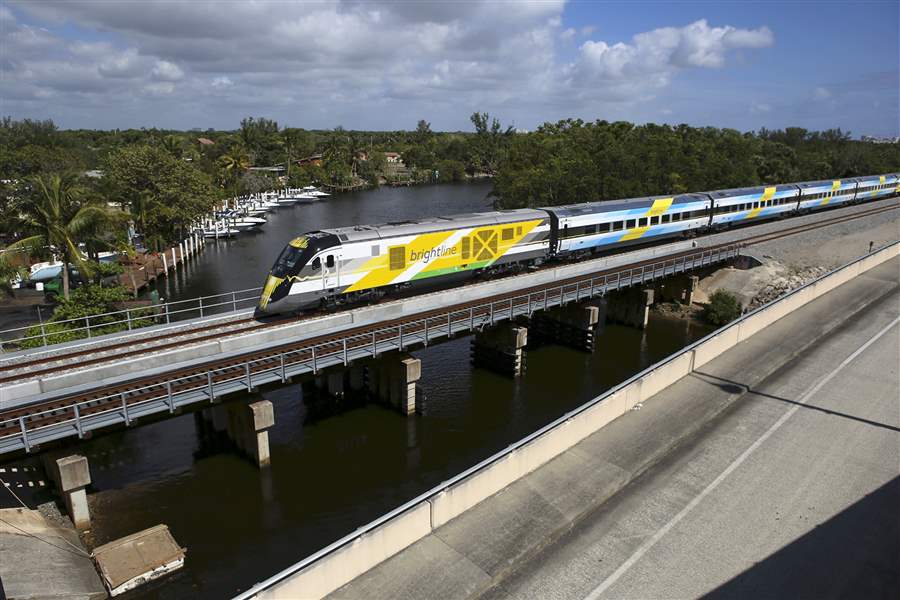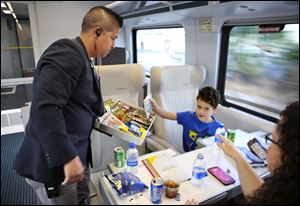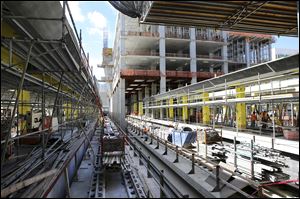
Brightline train looks to revive intercity rail travel
4/13/2018
A Brightline train crosses the Hillsboro Canal near Deerfield Beach, Fla., on March 30, 2018.
THE BLADE/DAVID PATCH
Buy This Image

A Brightline train crosses the Hillsboro Canal near Deerfield Beach, Fla., on March 30, 2018.
WEST PALM BEACH, Fla. — When Henry Flagler set about building what became the Florida East Coast Railway more than a century ago, he had real-estate and resort development in mind.
Now, a company with FEC roots is reviving passenger-train service on that line half a century after it ended, with a similar motive.
Just six years after an FEC official first conceived of it, Brightline began running trains in January nonstop between Fort Lauderdale and West Palm Beach, offering a 40-minute travel time between those cities’ downtowns.
Service is slated for extension to downtown Miami sometime this spring; test operations to the MiamiCentral station complex began in late March.
RELATED: Brightline skeptics worry about safety
Within a few more years Brightline plans to link those three cities with Orlando. A 125 mph top speed would make it the second-fastest line in the United States and would allow a three-hour running time between Miami and the nation’s top tourist destination. For drivers, that 230-mile trip takes about 3½ hours — if there are no delays.
It’s the first privately run, daily intercity passenger service introduced in the United States in more than half a century.
When the previous generation of privately operated passenger trains shriveled to nearly nothing during the 1960s, the automobile was king and South Florida, while growing, had nowhere near the population — or congestion — it has today, said Patrick Goddard, a native of Ireland who was recruited to Brightline 1½ years ago not from Amtrak or a transit agency but from Trust Hospitality, a developer of independent luxury hotels..
“It’s come full circle,” he said, “and we are excited to be able to solve this problem. Mobility overall, people are starting to think about it differently. We’re part of an overall solution for a lot of these markets, and other solutions dovetail into our intercity service.”
“They’re replicating what Henry Flagler did,” said Jim Kovalsky, president of the Florida East Coast Railway Society. “They’re not building a railroad — they’re building a destination and a railroad to serve it. This is not just a passenger train, it’s an entire development system.”
But while the train was inspired in part by studies showing a robust desire for intercity rail service in southern and central Florida — a desire left unfulfilled when state officials twice rejected federal funding for such service — Brightline’s chief operating officer said there’s a lot more involved in the $3 billion project than just transportation from one city to another.
Brightline’s plan is to “take what is treated as a commodity — especially in this country — and make it into an experience,” Goddard said.
And the project is more than just a railroad. It also includes 4 million square feet of “transit oriented development” near the Miami, Fort Lauderdale, and West Palm Beach stations, including office space, dwellings, and retail.
Brightline is “the only company in the country developing both the transportation system and the surrounding transit oriented development,” according to a company summary.
WATCH: Brightline brings new rail service to Florida.
The Brightline ‘experience’
The initial service provides 11 weekday round trips between West Palm Beach and Fort Lauderdale and 10 on weekends — with later evening service on the weekends.
The Brightline “experience” starts in its stations. Passenger lounges evoke modern hotel lobbies, with large easy chairs, couches, work areas, and reservable conference rooms.
The smaller stations in West Palm Beach and Fort Lauderdale feature dual snack bars — one with ready-to-eat choices, the other do-it-yourself — and the much larger Miami station is planned to have “a signature restaurant” along with its passenger lounges.
Station access is controlled through single entry points, with travelers passing through a security checkpoint between the lobby and the lounge area, where they remain until a train boarding announcement is made. Only then do they go to the platform.
The trains have two classes of seating — Smart and Select — with two-by-two seating in the former and two-by-one in the latter. All coaches are fully accessible. They are equipped with modern lavatories large enough to accommodate wheelchairs and fully enclosed connections with wide doors between the coaches.
Built specifically for Brightline by Siemens in California, the trains at startup have three Smart-class cars and one Select car, with a total seating capacity of 239.
Snack service now is offered by attendants walking through the train, but once service to Orlando begins, Brightline plans to add a snack car to the trains as well as one additional coach for each seating class.
Tickets may be purchased at the station or in advance online. But don’t expect to buy one without a major credit card — Brightline doesn’t accept cash.
To promote the service, Brightline has offered introductory one-way fares of $10 for Smart class and $15 for Select, with the upgrade including free snacks and one free mixed drink for all passengers in the first-class car.

Gavin MacArthur, 8, of Pembroke Pines, Fla., chooses a cookie from a snack tray offered by Brightline train attendant Jose Garcia during a trip from Fort Lauderdale to West Palm Beach, Fla. on March 28, 2018.
“It’s great — really great,” Jim Barnett of Stratford, Conn., said after arriving in West Palm Beach from Fort Lauderdale with his wife, Betty, on a recent afternoon. “I can’t wait until it goes to Miami. And Orlando — that would be fabulous.”
Breckenridge, Colo., resident Jim Livingston rode the train up from Fort Lauderdale after flying in from Spain. The professional yacht captain had ferried one private yacht from West Palm Beach to Barcelona earlier this year and was about to repeat that voyage with another.
Without the train, he said, “I probably would have rented a car, or found a ride with somebody else in yachting. But it’s nice not to have to rely on somebody else. ... And when it’s going all the way to Miami, it’ll be a big thing, because the best flights are in Miami.”
The real estate play
But the new trains aren’t just for snowbirds like the Barnetts or visitors like Mr. Livingston.
Ed Walker, a bankruptcy lawyer from West Palm and one of Brightline’s strongest advocates, said the new train stations’ convenience to downtown destinations will save him time and his clients money.
Until now, his primary means for work travel was driving on I-95, which in South Florida is congested and crash-prone, making travel times uncertain.
“My biggest fear, being an attorney, is being late, so I end up leaving three hours early to get to Miami,” he said. “And driving really puts you in a bad mood. ... With the train, you can have productive travel time, or just take a nap or have a drink, and you arrive relaxed and ready to work.”
West Palm Beach resident Annie Vela formerly rode TriRail commuter trains from her home city to work as the controller for a Fort Lauderdale law firm — a commute that involved riding a shuttle bus between TriRail’s edge-of-town station and downtown Fort Lauderdale.
“Now I have a two-block walk instead of riding the shuttle,” she said. “And the Wi-Fi works, and it’s clean.”
Introductory fares will continue for about a month after the Miami station opens.
After that, Brightline plans to switch to a “more dynamic pricing model” with fares that vary with the time of day and demand for specific trips
Miami also is where Brightline is making its biggest real-estate play, building three office and residential towers at the new MiamiCentral train station — two of them above the terminal and one just to its west.
Along with Brightline’s tracks, MiamiCentral has stations for that city’s Metrorail rapid-transit line, its automated MetroMover downtown loop, and the TriRail commuter trains that now run between West Palm Beach and Miami International Airport.
The complex on downtown Miami’s northwest edge is also near the historically black Overtown neighborhood and will feature a supermarket to serve what is now a “food desert” in that part of Miami, said Ali Soule, a Brightline spokesman.

In a view looking south toward the MiamiCentral 1 office tower, construction progresses on Brightline's Miami Central terminal complex in Miami, Fla. on March 27, 2018.
Other developers are already building on neighboring land, Ms. Soule said. A recently announced construction project in West Palm Beach also cited Brightline’s proximity as a motivating force.
The Fort Lauderdale station is adjacent to a hub for that city’s transit buses, while the West Palm Beach station is within walking distance not only of downtown office and government buildings but also its Central Park historic district.
All three stations have dedicated parking garages along with their local transit connections.
Travel’s changes
Mr. Flagler, who made a fortune in the late 19th century as one of Standard Oil’s leaders, became enamored with Florida’s potential for hotel and resort development during a late 1890s visit to St. Augustine with his ailing wife.
At the time, railroads were the most effective means of land travel. So Mr. Flagler bought up railroads between Jacksonville and Daytona, then built his own down the Atlantic coast as far as West Palm Beach and then Miami — then a small fishing village.
Florida law rewarded his company with vast land grants in exchange for providing the railroad infrastructure, and thus FEC became a prominent real-estate player all along the corridor.
But America’s intercity passenger trains began a steep decline during the 1950s as travelers abandoned them in favor of driving or flying.
When unions in 1963 began what proved to be a violent strike against FEC over work rules, Florida’s remaining long-distance passenger trains were rerouted onto the alternative, longer routes Amtrak uses to this day.
State regulators in 1965 forced FEC to re-establish minimal service over its own rails between Miami and Jacksonville, but those trains ended in 1968.
For the next two decades, Amtrak operated the only passenger trains in Florida. Even when TriRail began running in 1989, it was intended to be a temporary option while the Florida Department of Transportation widened adjacent I-95.
But the commuter trains were popular enough with riders that they kept running after the I-95 work was done and since then, TriRail has expanded several times.
For longer-distance rail travel, Amtrak’s two daily round trips between Miami and New York via Orlando and Jacksonville — with one making a side trip to Tampa along the way — had been, before Brightline, the only game of late in south Florida.
Amtrak’s fastest time to cover the 265 miles between Miami and Orlando is 5½ hours, for an average speed of 48 mph, and like most Amtrak long-distance trains they often run late.
Miami and more
Federal funding for faster trains in Florida came and went twice.
In 1999, then-Gov. Jeb Bush scuttled a $6.3 billion plan for French-designed 200 mph passenger trains between Miami and Tampa via Orlando. Eleven years later, Gov. Rick Scott turned back a $2.4 billion federal contribution toward another high-speed rail plan for South Florida.
It was the second project’s cancellation, Mr. Goddard said, “that really was the catalyst for Fortress” — Fortress Investment Group, which at the time owned the Florida East Coast Railway.
“There are 20 years of studies that are screaming out for a mobility solution between Miami and Orlando,” he said, later adding, “We’re not losing sight of the fact that we’re solving a major mobility problem here.”
Fortress set up what was initially known as All Aboard Florida to develop the passenger trains and arrange financing. All Aboard Florida later created the Brightline brand name.
Ownership of the railroad that accounts for most of the route gave Fortress a free hand, although it did assign to its new passenger operation the cost of reinstalling many miles of second main track.
And the last 40 miles into Orlando will use new track to be built from a connection to the FEC near Cocoa, Fla., and run parallel to the Beach Line Expressway to Orlando International Airport — the only one of Brightline’s four major stations that won’t be downtown.
Orlando’s airport authority already has built the station, which is intended to serve Brightline as well as Orlando’s SunRail commuter line and a proposed magnetic-levitation train between the airport and downtown.
Crossing a mostly uninhabited stretch of pine and scrub, the new track between Orlando and Cocoa is the section where Brightline expects its trains to reach 125 mph. Between Cocoa and West Palm Beach the planned top speed is 110 mph, while the trains between West Palm and Miami top out at 79 mph.
“Obviously, we’re laser-focused on getting Miami open,” Mr. Goddard said when asked about a timetable for Orlando.
Also uncertain is whether any intermediate stops will be made between West Palm Beach and Orlando.
Stuart, with a picturesque waterfront and walkable shopping district, would be a plausible location, although it has little land available to build a station consistent with Brightline’s design standards.
It’s also in the heart of anti-Brightline country; the St. Lucie River and its contentious railroad bridge are at its downtown’s north end.
Fort Pierce and Melbourne are other candidates, with the former even having offered to build a station at its own expense.
Mr. Goddard was noncommittal about any of them.
“Part of the beauty of being private is that we can look at the individual demographics of each city and decide if we want to stop there,” he said.
Contact David Patch at dpatch@theblade.com or 419-724-6094.